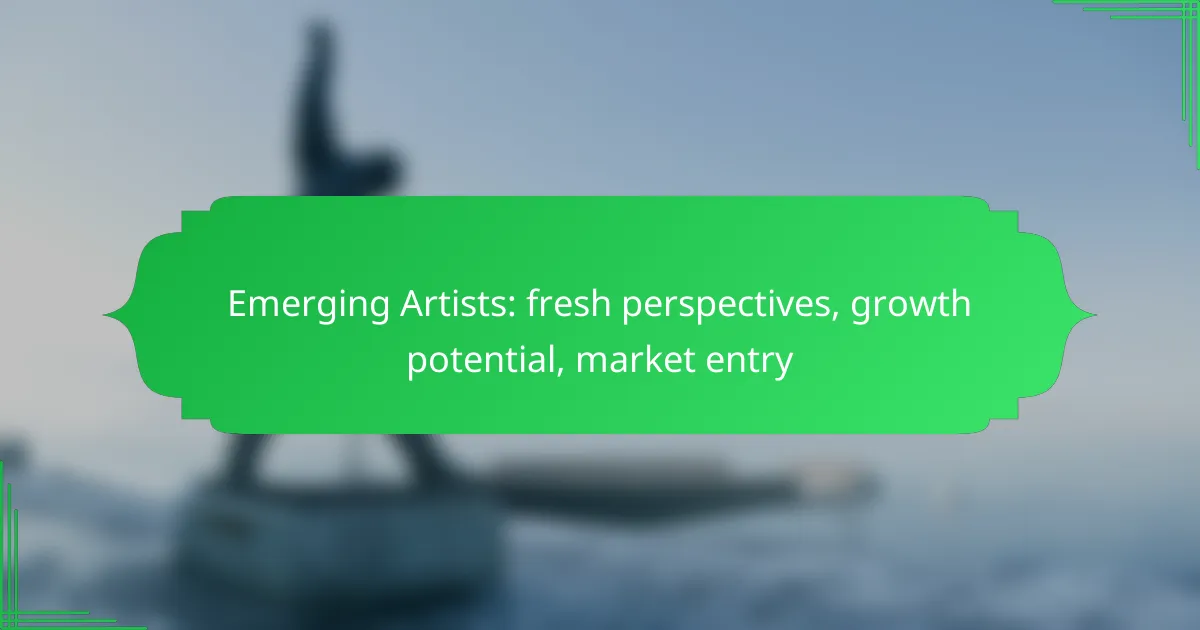Emerging artists are poised to bring fresh perspectives to the art world, leveraging innovative strategies to gain visibility and connect with audiences. With the rise of digital platforms, these artists have unprecedented opportunities for growth, allowing them to navigate challenges such as market saturation and funding limitations. By embracing collaboration and engaging with established networks, they can effectively enter the market and cultivate a dedicated following.
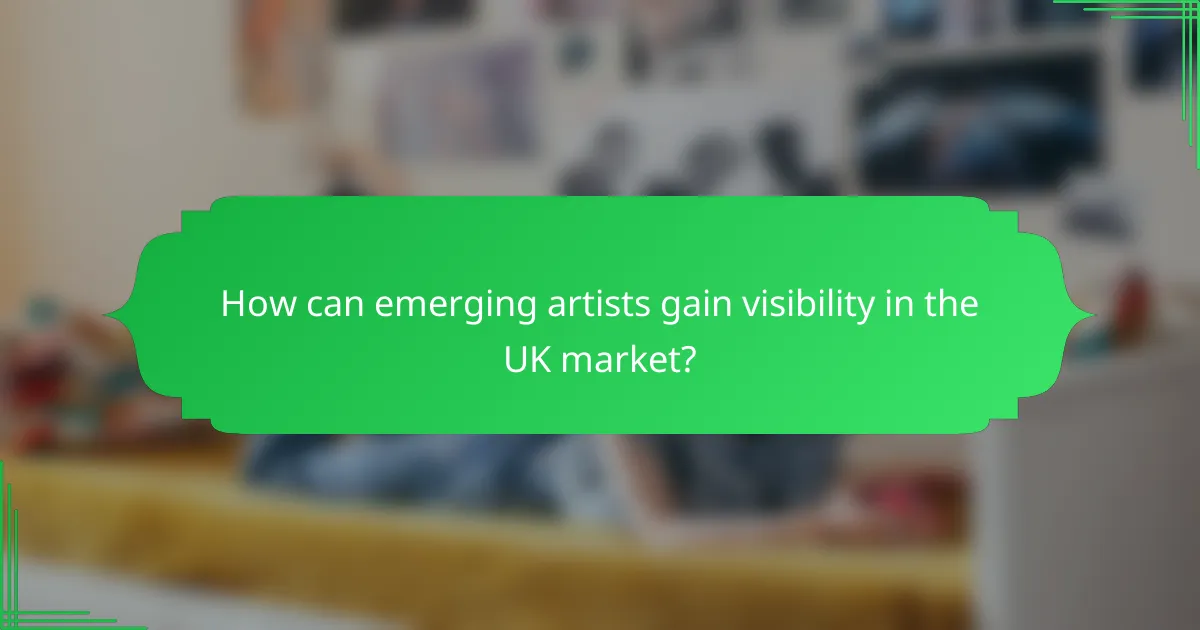
How can emerging artists gain visibility in the UK market?
Emerging artists can gain visibility in the UK market by leveraging various strategies that enhance their exposure and connect them with potential audiences. Key methods include utilizing social media, collaborating with established artists, participating in local art fairs, engaging with art influencers, and creating an online portfolio.
Utilizing social media platforms
Social media platforms like Instagram, Twitter, and Facebook are essential for emerging artists to showcase their work and build a following. Regularly posting high-quality images of artwork, engaging with followers, and using relevant hashtags can significantly increase visibility.
Artists should consider creating a content calendar to maintain consistency and plan promotional campaigns around events or exhibitions. Engaging with other artists and participating in online challenges can also enhance reach.
Collaborating with established artists
Collaborating with established artists can provide emerging artists with credibility and access to a broader audience. Joint projects, exhibitions, or workshops can create unique opportunities for exposure.
When approaching established artists, it’s crucial to present a clear vision of the collaboration and how it benefits both parties. This can lead to valuable networking opportunities and mentorship.
Participating in local art fairs
Local art fairs are excellent venues for emerging artists to display their work and connect with potential buyers and collectors. These events often attract art enthusiasts and industry professionals looking for fresh talent.
To maximize impact, artists should prepare a professional display and consider offering promotional materials, such as business cards or brochures, to facilitate follow-up connections.
Engaging with art influencers
Art influencers can significantly amplify an emerging artist’s visibility by sharing their work with a larger audience. Building relationships with influencers through social media or direct outreach can lead to features or collaborations.
Artists should research influencers whose aesthetic aligns with their work and approach them with a personalized message that highlights mutual interests. This targeted engagement can enhance credibility and reach.
Creating an online portfolio
An online portfolio is crucial for emerging artists to showcase their work professionally. Platforms like Behance, ArtStation, or personal websites allow artists to present their pieces in a curated manner.
When creating a portfolio, artists should focus on high-quality images, clear descriptions, and an easy navigation structure. Regular updates with new work and projects can keep the portfolio fresh and engaging for visitors.

What are the growth opportunities for emerging artists?
Emerging artists have numerous growth opportunities in today’s dynamic art landscape, particularly through digital platforms and innovative marketing strategies. By embracing new trends and leveraging online resources, artists can expand their reach and cultivate a dedicated audience.
Exploring digital art trends
Digital art trends are rapidly evolving, offering emerging artists a chance to experiment and innovate. Popular styles include NFTs, augmented reality, and interactive installations, which can attract attention and create unique experiences for viewers.
Staying updated on these trends is crucial. Artists should engage with online communities, follow influential digital artists, and participate in virtual exhibitions to gain insights and inspiration.
Leveraging online marketplaces
Online marketplaces provide a platform for emerging artists to sell their work directly to consumers. Websites like Etsy, Saatchi Art, and Artfinder allow artists to showcase their pieces without the need for a traditional gallery, often with lower fees.
When using these platforms, artists should optimize their listings with high-quality images and detailed descriptions. Regularly updating their portfolios and engaging with customers can significantly enhance visibility and sales potential.
Building a personal brand
Creating a strong personal brand is essential for emerging artists to differentiate themselves in a crowded market. This involves developing a cohesive visual identity, consistent messaging, and a unique artistic voice that resonates with their target audience.
Artists should utilize social media platforms like Instagram and TikTok to share their creative process, connect with followers, and promote their work. Regularly engaging with fans and collaborating with other artists can further strengthen their brand and expand their reach.
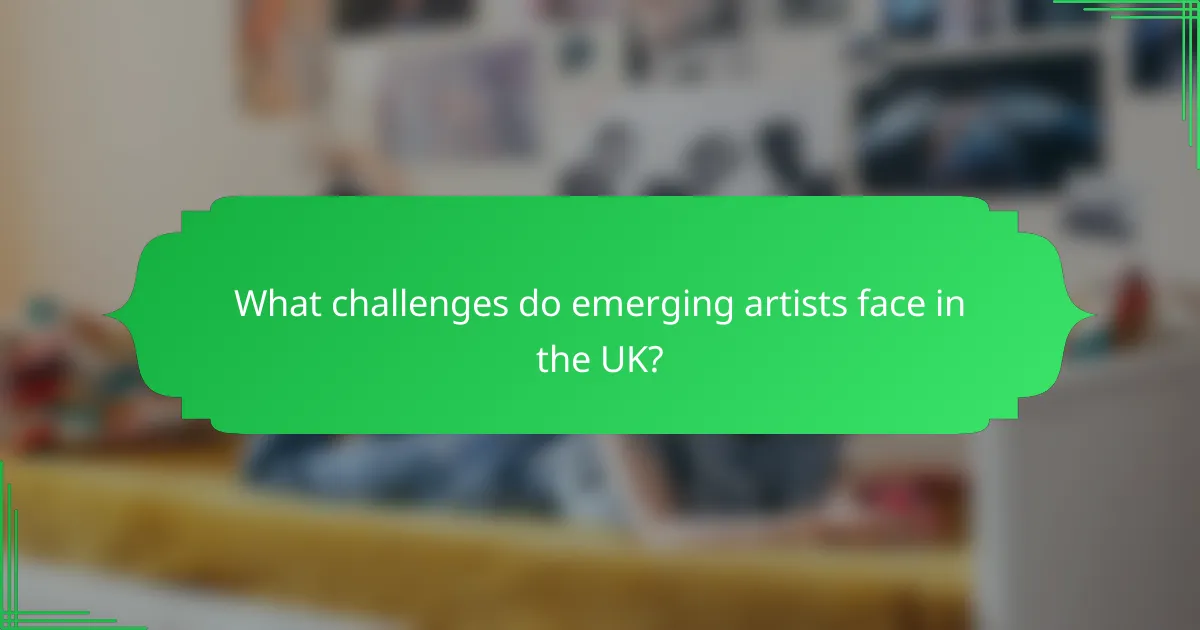
What challenges do emerging artists face in the UK?
Emerging artists in the UK encounter several significant challenges that can hinder their growth and market entry. Key issues include limited access to funding, market saturation, and the need to balance creative work with effective marketing strategies.
Limited access to funding
Many emerging artists struggle to secure funding for their projects, which can limit their ability to produce and promote their work. Traditional funding sources, such as grants and sponsorships, are often highly competitive, making it difficult for new artists to gain financial support.
Artists should explore alternative funding options, such as crowdfunding platforms or local arts initiatives, which can provide more accessible financial resources. Networking with other artists and industry professionals can also lead to potential funding opportunities.
Market saturation
The UK art market is highly saturated, with numerous artists vying for attention. This competition makes it challenging for emerging artists to stand out and gain visibility among established names and a plethora of new entrants.
To navigate this saturation, artists should focus on developing a unique style or niche that differentiates them from others. Engaging with specific communities or themes can help create a distinct identity that resonates with audiences and collectors.
Balancing creative work with marketing
Emerging artists often find it difficult to balance their creative pursuits with the necessary marketing efforts to promote their work. This dual focus can lead to burnout or a lack of visibility if not managed effectively.
Artists should consider setting aside dedicated time for marketing activities, such as social media engagement, networking events, and portfolio updates. Utilizing tools like scheduling apps can help streamline these efforts, allowing artists to maintain their creative flow while also building their presence in the market.
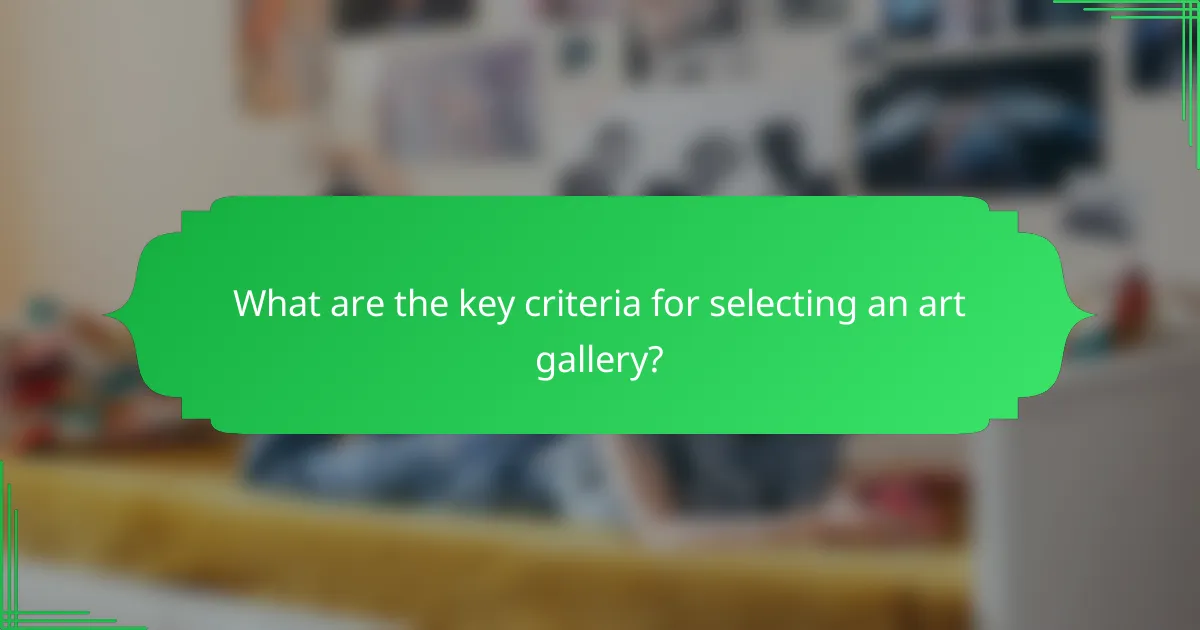
What are the key criteria for selecting an art gallery?
When selecting an art gallery, key criteria include the gallery’s reputation, its exhibition history, and the commission structure it offers to artists. These factors significantly influence an artist’s visibility, growth potential, and overall market entry success.
Gallery reputation and audience
The reputation of a gallery plays a crucial role in an artist’s career. A well-regarded gallery often attracts a discerning audience, including collectors, critics, and curators, which can enhance an artist’s credibility and marketability.
Consider researching the gallery’s past exhibitions and the types of artists they typically represent. A gallery with a strong track record in a specific genre may be more beneficial for artists working within that niche.
Exhibition history
Exhibition history reflects a gallery’s experience and success in showcasing artists. Look for galleries that have hosted notable exhibitions or collaborated with respected institutions, as this can indicate a commitment to promoting artists effectively.
Artists should inquire about the frequency and scale of exhibitions at the gallery. A gallery that regularly holds shows can provide more opportunities for exposure and sales, which is vital for emerging artists.
Commission structure
The commission structure is an essential consideration for artists when choosing a gallery. Typically, galleries take a percentage of sales, which can range from 30% to 50%. Understanding this structure helps artists gauge their potential earnings.
Artists should also clarify any additional fees or costs associated with exhibiting their work. Some galleries may charge for marketing or installation, which can impact an artist’s overall profitability.
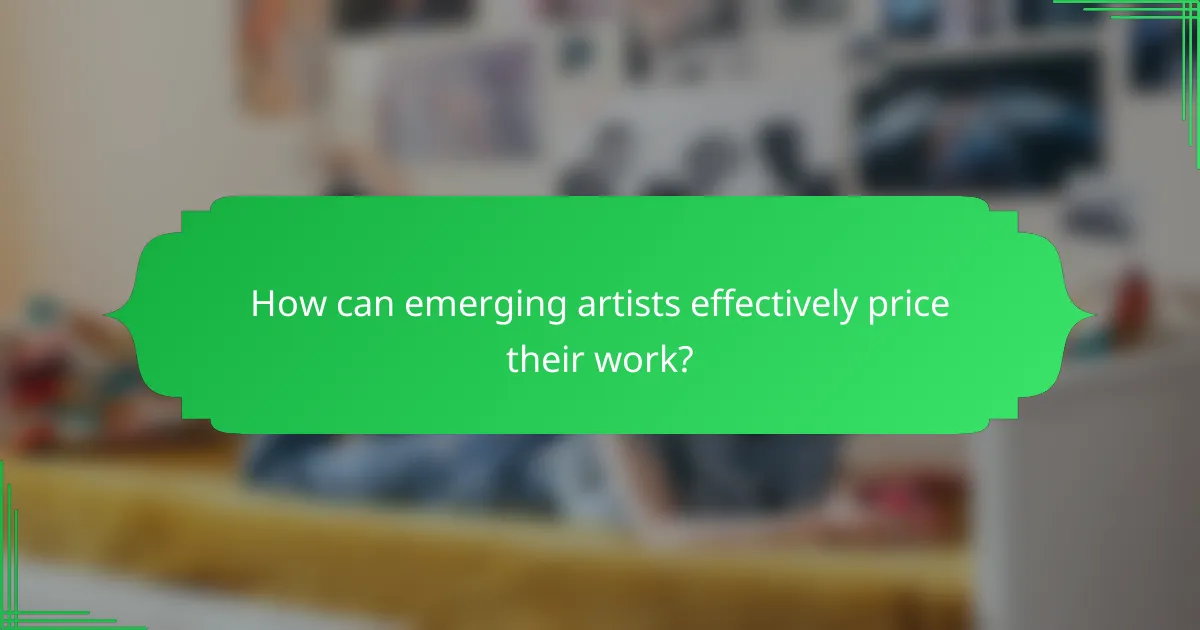
How can emerging artists effectively price their work?
Emerging artists can effectively price their work by understanding market dynamics, accounting for material costs, and evaluating the time invested in their creations. A balanced approach ensures that pricing reflects both the artist’s value and the market’s expectations.
Researching market rates
To set competitive prices, emerging artists should research current market rates for similar artworks. This involves looking at local galleries, online platforms, and art fairs to gauge what other artists with comparable experience and style are charging.
Online resources like art marketplaces or social media platforms can provide insights into pricing trends. Artists might find that prices for original works can range from a few hundred to several thousand dollars, depending on factors like size, medium, and reputation.
Considering material costs
Material costs play a crucial role in pricing artwork. Artists should calculate the expenses for supplies such as paint, canvas, and framing, ensuring these costs are reflected in the final price. For instance, if materials cost around 20-30% of the desired sale price, this should be factored in to maintain profitability.
Additionally, artists should consider the quality of materials used, as higher-quality supplies can justify higher prices. Keeping a detailed inventory of material costs can help artists make informed pricing decisions.
Evaluating time invested
The time invested in creating artwork is another key factor in pricing. Artists should track the hours spent on each piece, from conception to completion, and consider their hourly rate. For example, if an artist values their time at $20 per hour and spends 15 hours on a piece, this would add $300 to the price.
It’s important to strike a balance; while artists should be compensated for their time, they must also remain competitive in the market. A common pitfall is underpricing due to a lack of confidence in one’s work, which can undermine long-term sustainability.
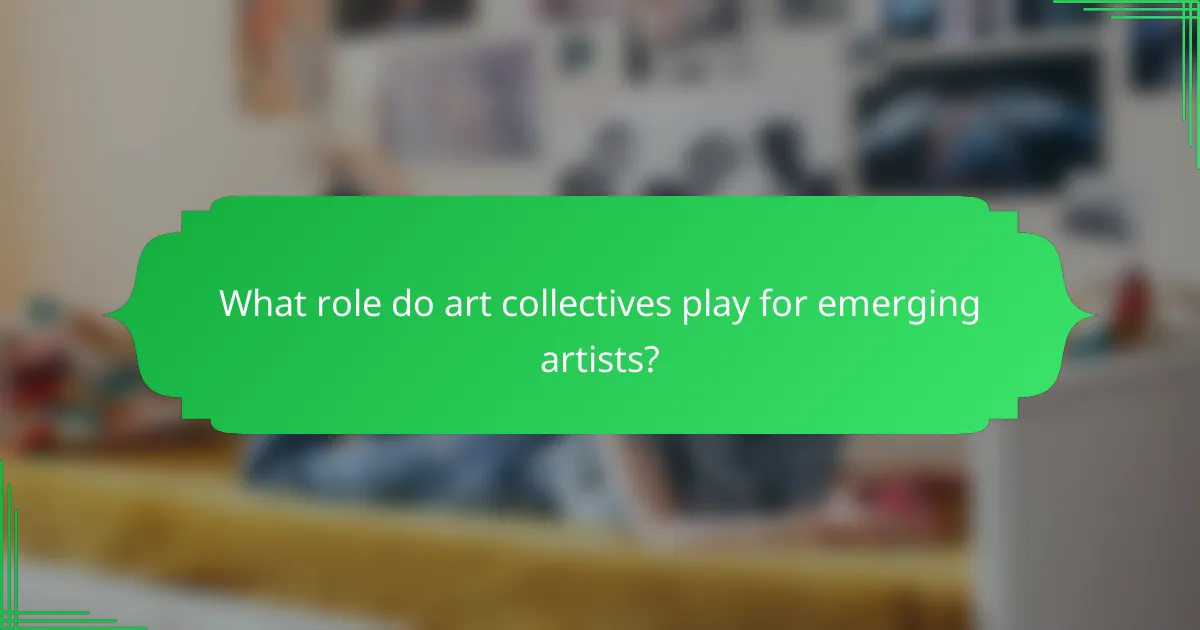
What role do art collectives play for emerging artists?
Art collectives provide essential support and resources for emerging artists, fostering collaboration and community. They offer a platform for artists to share ideas, showcase their work, and access opportunities that might be difficult to obtain individually.
Collaboration and Networking
Art collectives facilitate collaboration among artists, allowing them to pool their skills and resources. This networking can lead to joint exhibitions, shared studio spaces, and collective projects that enhance visibility and reach.
By working together, emerging artists can learn from each other, receive constructive feedback, and build valuable connections within the art community. These relationships can often lead to mentorship opportunities and introductions to galleries and collectors.
Access to Resources
Joining an art collective often grants emerging artists access to shared resources such as studio space, tools, and funding opportunities. This can significantly reduce individual costs and provide a supportive environment for creative development.
Many collectives also organize workshops, exhibitions, and events that can help artists gain exposure and improve their skills. These resources are particularly beneficial for those who may not have the financial means to pursue art independently.
Market Entry and Visibility
Art collectives play a crucial role in helping emerging artists enter the market by providing platforms for visibility. Collectives often host exhibitions and events that showcase their members’ work, attracting potential buyers and art enthusiasts.
Additionally, being part of a collective can enhance an artist’s credibility, making it easier to gain recognition in a competitive market. Collectives can also help artists navigate the complexities of art sales, pricing, and marketing strategies.
